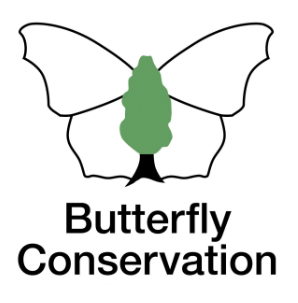Brown Argus
Brown Hairstreak
Chalkhill Blue
Clouded Yellow
Comma
Common Blue
Dark Green Fritillary
Dingy Skipper
Essex Skipper
Gatekeeper
Green Hairstreak
Green-veined White
Grizzled Skipper
Holly Blue
Large Skipper
Large White
Marbled White
Meadow Brown
Orange-tip
Painted Lady
Peacock
Purple Emperor
Purple Hairstreak
Red Admiral
Ringlet
Silver-washed Fritillary
Small Blue
Small Copper
Small Heath
Small Skipper
Small Tortoiseshell
Small White
Speckled Wood
Wall
White Admiral
White-letter Hairstreak
Extinct/rare immigrants
Meadow Brown
Maniola jurtina
General Distribution and Status
The Meadow Brown is widespread in Britain and our most abundant butterfly. It is absent on land higher than 300m and areas of intensive agriculture. The numbers were probably higher in the 19th and the early part of the 20th century before agricultural intensification began when hay meadows were cut (Asher et al.). Very little change in its range and abundance is apparent since the 1970s. The situation in Hertfordshire and Middlesex is a concern with numbers falling by more than double in 2015 since the start of the survey in 1995 on transect sites (Wood, 2016) and no genuine recovery has taken place since then.
| United Kingdom | Herts & Middx | |||
| Distribution | 1976-2019 | -22% | 1980-2015 | -5% |
| Average 10-year trend | -4% | 2006-2015 | +15% | |
| 2024 since 2015-19 | +19% | |||
| Abundance | 1976-2024 | +1% | 1980-2015 | -234% |
| 2015-2024 | +5% | 2006-2015 | -32% | |
| 2023-2024 | -33% | 2024 since 2015-19 | -26% | |
UK distribution map
UKBMS Species summary
Habitat Requirements
This species is found on most types of grassland except on the very shortest turf.
Larval Foodplants
Sawford mentions Smooth-stalked Meadow Grass Poa pratensis as seemingly the principal foodplant. Other main foodplants include Bent Agrostis sp., Cock's-foot Dactylis glomerata, Common Couch Elytrigia repens, Fescue Festuca spp and Wood Meadow Grass Poa nemoralis.
Adult Food Sources
Thistle Cirsium sp. (391), Buddleia Buddleja davidii (267), Common Ragwort Senecio jacobea (107), Wild Marjoram Origanum vulgare (106).
Historical Records
Evidence suggests that the butterfly had always been comparatively abundant in Hertfordshire although Waterton in his 1970-81 report noted its decline relative to the Gatekeeper, possibly as a result of changes in agricultural practices.
Local Distribution and Abundance
As shown on the map, the Meadow Brown is widespread in the Stevenage area. We received a report of a sighting in the TL22C square around St Ippolyts on 3 August 2021, the first record here since 2006. Hundreds were often counted in the late 1990s and the early part of this century at Knebworth Park with an estimated number of 500 at Knebworth Park on 25 July 2001 reported by Trevor Chapman. Norton Green Common, Fairlands Valley Park and Great Ashby Park are also excellent sites. An unusually large number of males in 2018 were on the small side probably caused by rapid development in the larval stages in the hot and dry weather in June which led the larvae to pupate early.

Stevenage (South Fairlands Valley Park) transect 1993-2025
The abundance trend mirrors what is happening elsewhere in Hertfordshire. About half the numbers were in Millennium Wood in around 2004-2006 like the Gatekeeper but the Meadow Brown appeared to have utilised other areas in the park better facilitating a partial recovery since 2010. Management of the park in the last few years by less regular cutting in the grassland areas has also helped. The total for 2018 would have been higher if Shackledell Grassland was not drastically cut on 16 July, during the butterfly's flight period. However, it was a record season in 2019 with good numbers seen over a longer period but numbers dropped back in 2020 perhaps because of the effects of the drought in the spring. Dry conditions in 2021 and 2022 might have contributed to numbers declining further but increases arose in the warm and dry weather in 2025.
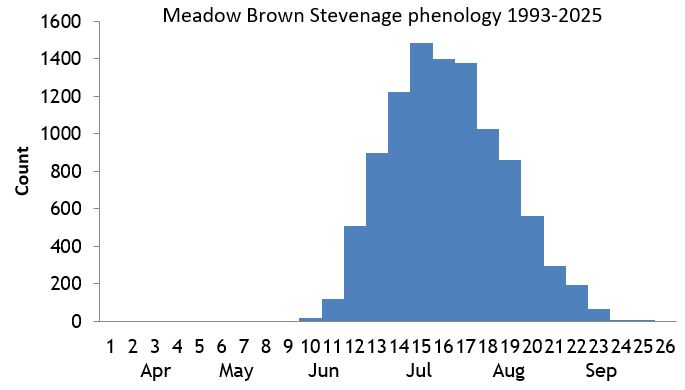
Knebworth Park transect 1996-2010 and 2017-2025
After an abundant season in 2005 this species appears to have declined. There was a significant reduction in 2018 compared to 2017 possibly due to the effects of the hot and dry weather in June which may have impacted some of the butterfly's food-plants. However, 2019 saw more than twice the number of sightings recorded in 2018. The north-western section of the park is the most favoured site. In 2020, drought in the spring as in 2018, appeared to have contributed to fewer adults than usual.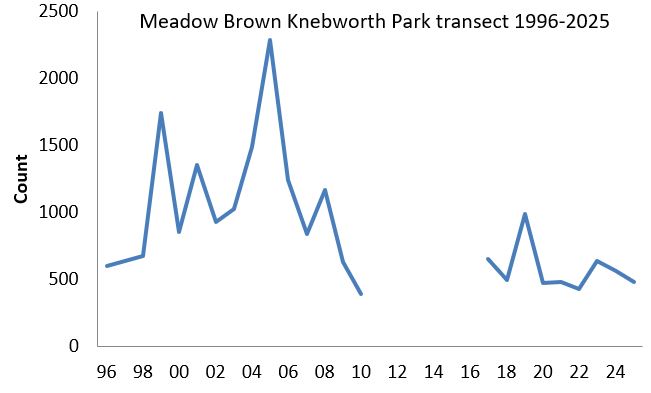
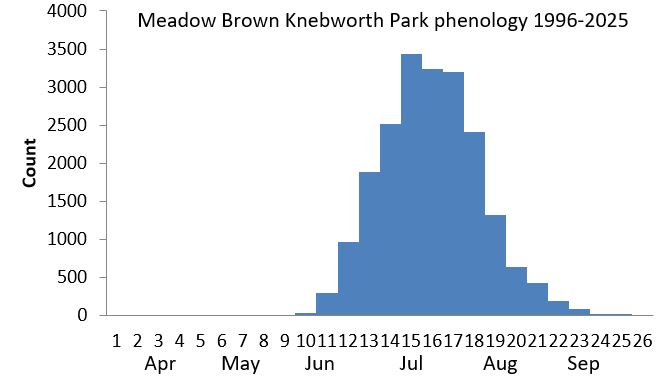
Knebworth Woods transect 2017-2025
The declines in 2018 and 2020 occurred probably for the same reasons cited above but there was a pick-up in abundance in 2019 as occurred on the other two local transects. However, numbers have dropped each year since 2019 although the fine weather in 2025 saw a small recovery.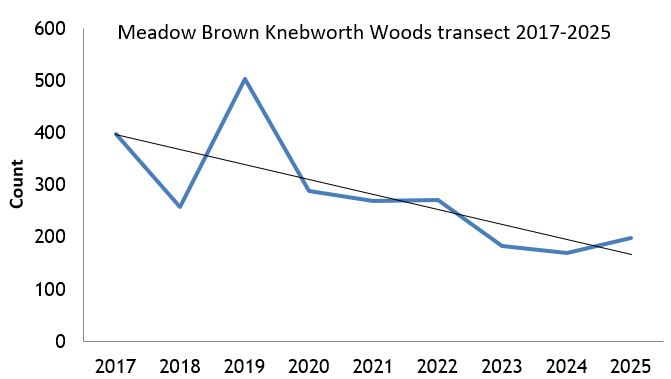
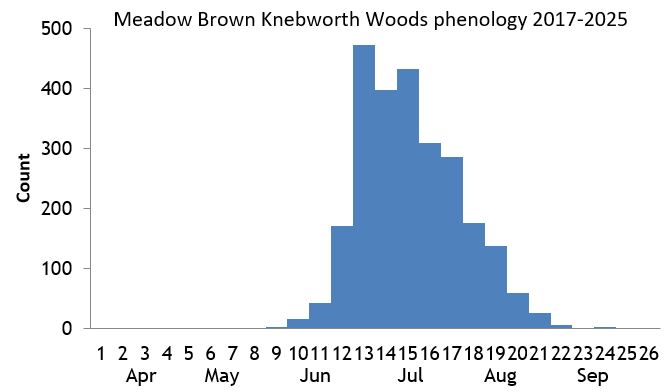
<
Pryor's Wood transect 2000-2022
Although numbers had fallen since 2008, 2018 saw a good recovery and even more so in 2019 when over 200 specimens were recorded, the best year during the survey, including three weekly counts of over 50 in July. However, in line with the other local transects, there was a notable decline in numbers in 2020 and worse to follow in 2021 and 2022.Life History
Earliest date: 24 May 2009 at Great Ashby Park
Latest date: 8 October 1995 at Luffenhall
A single generation is produced
per year although sightings in the autumn might suggest a very small second brood but so far there is no clear evidence that this occurs. Numbers peak
in the middle of July but the flight season is very long, due to varying rates of larval development in the spring, so quite a few individuals can often
be seen in September. Eggs are laid singly or just simply dropped into the vegetation. Larvae feed on the grasses and overwinter until the spring when
they pupate low amongst the vegetation suspended on a stem.
Behaviour/Observation notes
Males usually emerge days earlier than females and for both sexes they emerge earlier in warm open situations than on hedgerows and edges of woodland. Where found, they are very conspicuous and easy to photograph. Females can be confused with female Gatekeepers; see differences in the account for the Gatekeeper. Males on the other hand, can look like Ringlets at a distance especially with faded specimens although for experienced observers the floppier flight of the Ringlet is characteristic.
Variations/Aberrations
There are many studies regarding the ecology of the Meadow Brown including the study of regional subspecies and aberrations of which
there are many involving spot patterns and colouring of the wings. One aberration which has appeared a few times recently in Hertfordshire is ab. alba
where the fulvous patch on the forewings is replaced by white. Alan Cockburn saw one near Weston in 1998 and again in the same area in 2001. I found one near
Watery Grove on 1 August 2016. Because of the usual abundance of this butterfly, aberrations or variations are worth investigating.
Find out more on the UK Butterflies website
Variation in the number of dark spots on the hindwing undersides has attracted much attention. In the middle of the last century Professor E. B. Ford and W.H. Dowdeswell undertook a lot of research on this subject. They concluded that there were regional variations in the number of spots on females in England; in south-west Cornwall the spread of the number of spots was relatively uniform whereas elsewhere in southern England (Devon in the west, Suffolk in the east and Warwickshire in the north) samples showed that about 60% of females had no spots. Only about 1% of females in both groups and sexes possessed four or more spots (Dowdeswell). I was lucky enough to find such a specimen at Fairlands Valley Park on 15 June 2016 - see photo. It is unknown if current populations hold a similar distribution pattern. Paul Brakefield discovered that genes controlled the number of spots to aid the butterfly's survival in different environmental conditions. In general, males are more active and having more spots help to deflect any predatory birds from attacking the body. Females, being more sedentary, need more camouflage in the vegetation so possessing fewer spots help in that cause (Thomas & Lewington).
References
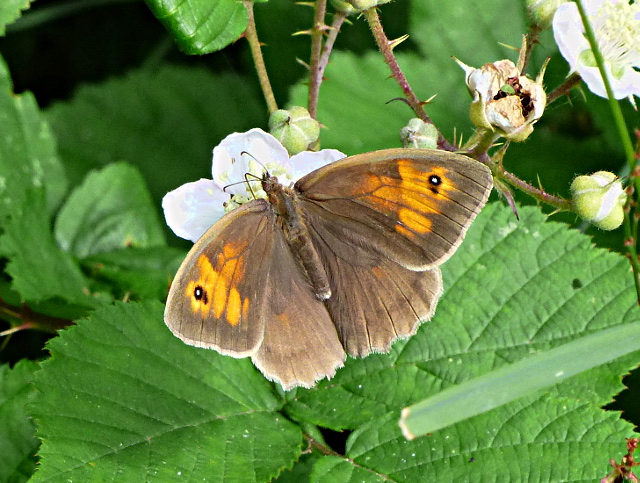
Six Hills Common 2 Jul 2016 (f)

Shackledell Grassland 23 Jun 2015 (m)
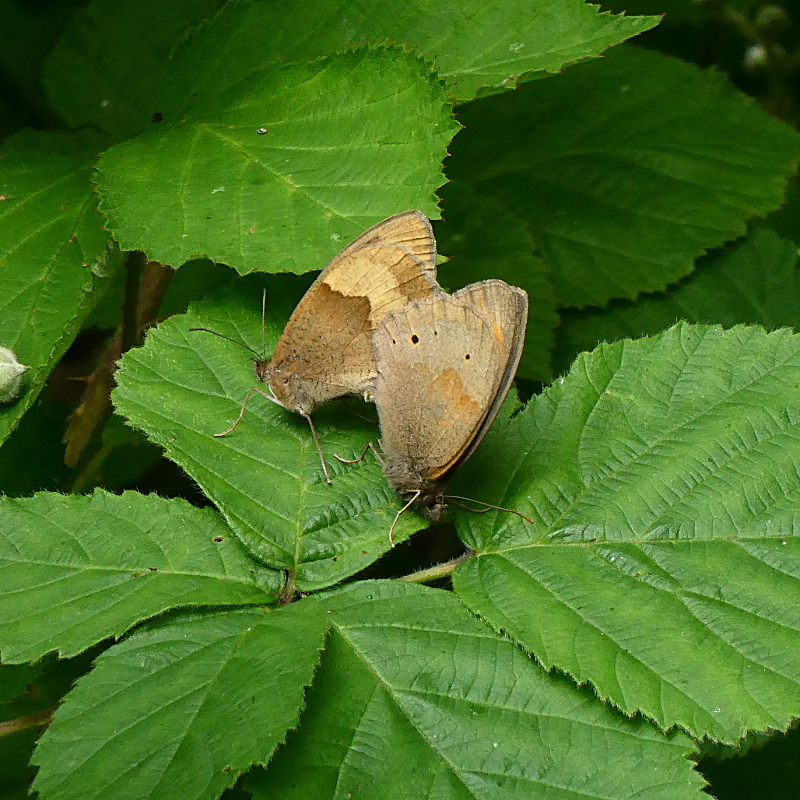
Whomerley Wood 8 Jul 2021
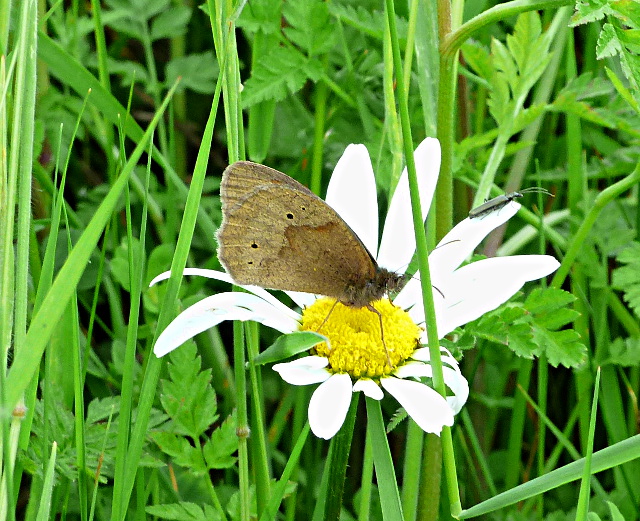
Fairlands Valley Park 15 Jun 2016 - 4 spots
